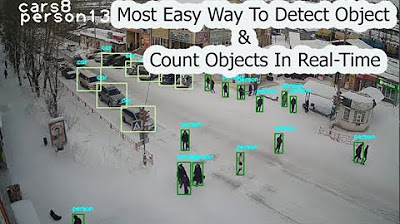Nyoba Code 8: Ide Skripsi Hitung Kendaraan dengan Algoritma Deteksi Counter - Haar Cascade - SSD
Summary
TLDRIn this video, Ridwan Ilyas demonstrates how to use Python and OpenCV to count vehicles passing through a specific line in a video. The process includes three algorithms: contour detection, Haar Cascade, and SSD MobileNet. Ridwan walks viewers through each method, explaining key concepts like background subtraction, object tracking, and the detection of moving contours. By using these techniques, users can experiment with vehicle counting, improving their coding skills and applying the methods to real-world projects. The video also invites viewers to try the code and contribute ideas for further research or improvements.
Takeaways
- 😀 The tutorial explains how to detect and count vehicles passing a line in a video using Python.
- 😀 Three different algorithms are demonstrated: contour detection, Haar Cascade Classifier, and SSD MobileNet.
- 😀 The contour detection method identifies moving objects by analyzing their contours and counts vehicles that cross a defined line.
- 😀 The Haar Cascade Classifier algorithm detects specific objects, like vehicles, using pre-trained models.
- 😀 The SSD MobileNet deep learning model is used for object detection, including vehicles, offering better accuracy in distinguishing between various objects.
- 😀 OpenCV is used for video processing, background subtraction, and detecting contours and objects.
- 😀 A bounding box is drawn around detected vehicles, and the center of each vehicle is tracked to count the number of vehicles crossing the line.
- 😀 Contour detection sometimes leads to false positives, such as detecting moving objects like trees or animals.
- 😀 Haar Cascade has better precision in detecting vehicles compared to the contour detection method but may still produce false negatives or errors in detecting distant objects.
- 😀 SSD MobileNet provides a higher level of detection precision, though it can be slower and may still miss objects if they are far from the camera.
- 😀 The tutorial encourages further experimentation and improvement of the algorithms, highlighting how they could be adapted for real-world applications, such as traffic monitoring.
Q & A
What is the main purpose of the Python coding project discussed in the video?
-The main purpose of the Python coding project is to detect and count vehicles passing through a specific line on a road using video footage. The program will process the video and detect moving vehicles, counting how many cross the line.
What algorithms are implemented in the project to detect vehicles?
-Three different algorithms are implemented in the project: contour detection, the Haar Cascade Classifier, and SSD MobileNet.
How does the contour detection algorithm work in this project?
-The contour detection algorithm works by detecting moving contours in the video frames, drawing bounding boxes around them, and counting how many of those contours cross a predefined line.
What is the purpose of using the 'offset' variable in the contour detection algorithm?
-The 'offset' variable defines the buffer zone between the detection line and the detected vehicle. It allows for a margin of error, so vehicles detected within a specific range of the line are counted as having crossed it.
Why does the video sometimes detect objects like trees or grass as vehicles?
-Objects like trees or grass can be detected as vehicles because the contour detection algorithm identifies any moving object, not just vehicles. The wind moving trees or grass can create enough motion to be detected as a moving object.
What is the key difference between the contour detection algorithm and the Haar Cascade Classifier?
-The contour detection algorithm detects any moving object, while the Haar Cascade Classifier specifically identifies vehicles (cars) using a trained XML classifier to distinguish between vehicles and other objects.
How does the Haar Cascade Classifier identify vehicles?
-The Haar Cascade Classifier uses a pre-trained XML file that contains patterns and features of vehicles. It scans the video frame and detects whether a detected object matches these patterns, specifically identifying cars.
What are the limitations of the Haar Cascade Classifier as mentioned in the video?
-The Haar Cascade Classifier has some limitations, such as falsely detecting non-vehicle objects (like parked cars or large trees) as vehicles. Additionally, it can be slower and less accurate in detecting vehicles in certain scenarios.
What is the advantage of using SSD MobileNet for vehicle detection?
-The SSD MobileNet algorithm is more advanced and accurate in detecting vehicles because it uses a pre-trained deep neural network model. It specifically focuses on detecting objects like vehicles with higher accuracy compared to simpler algorithms like Haar Cascade.
Why does the author suggest experimenting with different algorithms for vehicle detection?
-The author suggests experimenting with different algorithms because each algorithm has its strengths and weaknesses. By testing various methods, users can identify the one that best fits their specific needs, such as real-time detection, accuracy, and performance.
Outlines

Этот раздел доступен только подписчикам платных тарифов. Пожалуйста, перейдите на платный тариф для доступа.
Перейти на платный тарифMindmap

Этот раздел доступен только подписчикам платных тарифов. Пожалуйста, перейдите на платный тариф для доступа.
Перейти на платный тарифKeywords

Этот раздел доступен только подписчикам платных тарифов. Пожалуйста, перейдите на платный тариф для доступа.
Перейти на платный тарифHighlights

Этот раздел доступен только подписчикам платных тарифов. Пожалуйста, перейдите на платный тариф для доступа.
Перейти на платный тарифTranscripts

Этот раздел доступен только подписчикам платных тарифов. Пожалуйста, перейдите на платный тариф для доступа.
Перейти на платный тарифПосмотреть больше похожих видео

25 - Reading Images, Splitting Channels, Resizing using openCV in Python

Python และ MediaPipe ร่วมกับ OpenCV ทำโปรแกรมนับนิ้ว "Finger Counting"

Persamaan Garis Lurus (4) | Menentukan Persamaan Garis Sejajar | Gradien Garis Sejajar

Object Detection using OpenCV Python in 15 Minutes! Coding Tutorial #python #beginners

Mengenal Topologi Ring | Komunikasi Data dan Jaringan Komputer Pertemuan 5

Most Easy Way To Object Detection & Object Counting In Real Time | computer vision | python opencv
5.0 / 5 (0 votes)
